”U.S. Virgin Islands, how much do you prioritize recovery after workouts? Recovery is what allows us to be prepared for our next workout! You can learn more about the importance of recovery in this week's article. We hope you find this helpful and informative!
Reading time: 15 Minutes
MWi Hacks:
- Find out what recovery debt is and how your body gets to that point
- Learn about some of the key functions that your body prioritizes to survive and thrive
MWi Summary:
- The “intensity mindset” refers to thinking the most important variable in exercise is how hard you train, but this often does not help you reach your ultimate goals.
- Training, stress, and recovery are related to the energy levels our bodies have. Our muscles, brains, and bones require ATP which is the energy currency of the body.
- A generally accepted model of energy is that if you have a higher level of activity, you will burn more calories. However, there are recent studies that refute this model. The new studies suggest that our metabolism is limited in the amount of energy it can produce.
- Our body’s energy demands go to three categories: vital biological functions, physical activity/stress, and tissue repair/adaptation.
- “Recovery debt” occurs when there is more stress on cells/tissues in training without sufficient time and energy they need to recover and repair.
Why “training hard” can lead to failure
It took me many years to fully understand what went wrong the second time around, but I’ve since come to realize that it all starts with what I call “the intensity mindset.”
What is the intensity mindset?
Simply stated, it’s approaching fitness from the idea that the single most important variable driving your success and results is how hard you train.
This mindset quickly extends to thinking that if you’re not seeing the results you want, it must be because you’re not training hard enough.
Or, just as commonly, if you’re training hard and seeing some results, then training harder will lead to even better or faster results.
The mindset that intensity is what drives results and there’s no gain without pain has been around in fitness for a long time. But the rise of Tabata intervals, and boot camp classes in the last ten years has only ingrained it deeper and deeper into the fitness culture.
Unfortunately, there’s one big problem with the intensity mindset: it doesn’t work.
In fact, it often ends up causing more harm than good in the long run. I’ve come to realize (and I have proof) that it’s the single biggest reason so many people put in the work and yet ultimately fail to reach their health and fitness goals.
Let me explain…
It all comes down to energy
To really dive into why the intensity mindset fails, we have to start by talking about energy. Every single one of our trillions of cells needs a constant and unending supply of energy to function and keep us alive.
Everything from our brains, to our muscles, and even our bones all rely on ATP, the energy currency of the body.
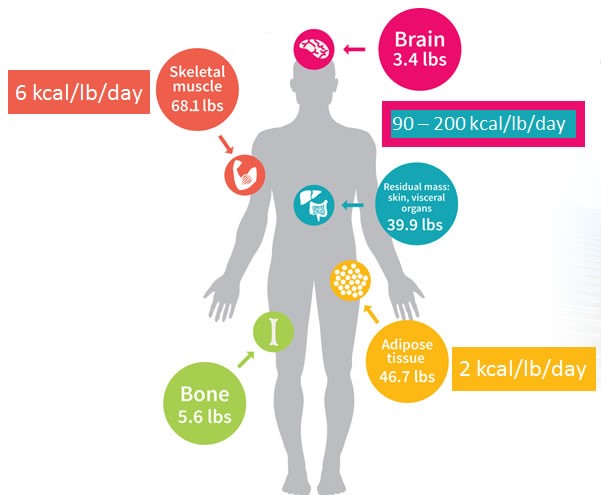
While the need for energy is obvious and something most people understand, what’s much less clear is how training, stress, and recovery are all directly related to energy and the results they see in the gym.
It’s because of this relationship that the intensity mindset is always destined to fail…
Why your Fitbit is a liar
One of the most important components of energy that’s come to light in recent years is that our body has a much more limited capacity to produce it than we realized. You see, most people believe that if they take more steps and are generally more active, it means they are burning more calories – i.e. their body is producing more total energy.
This idea has been repeated over and over again from pretty much every area of the fitness industry, from trainers and coaches, to nutritionists and everyone in between.
Move more, burn more. This is what’s known as the Additive Model of Energy Expenditure — which is just a fancy way of saying that the higher your level of activity, the more calories your body will ultimately burn.
This well-known concept is modeled in the graph below. You can see that “other” represents the number of calories you burn at rest (your RMR) and PA stands for physical activity. In this model, the more physically active you are, the more total energy (calories) you burn in a day.
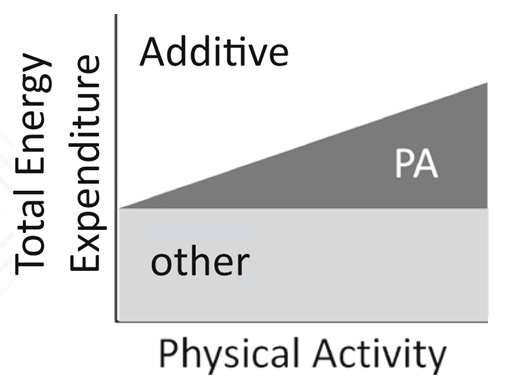
Although it makes perfect sense to think that this is the way the body works, more and more evidence is showing us that it doesn’t work this way at all. Instead, new research is painting an entirely different picture of metabolism and how our body adapts to different levels of physical activity.
In a research paper titled, “Constrained Total Energy Expenditure and Metabolic Adaptation to Physical Activity in Adult Humans,” researchers studied the physical activity levels and energy expenditures of five different groups of people living across the US and Africa.
Now, common-sense among most of the diet gurus out there might tell you that the populations in Africa that lived a more traditional hunter-gatherer lifestyle must have burned way more calories than us Americans because they were more active.
The research, however, found otherwise…
“People in less socioeconomically developed populations, including subsistence farmers and traditional hunter-gatherers, have total energy expenditures similar to those in more developed populations.”
The important thing to understand here is that the researchers didn’t just use a Fitbit, or some other accelerometer, to determine energy expenditure (calories burned) like most people would have to. Instead, they used a much more sophisticated technique called doubly labeled water.
This method provides a much more accurate gauge of how many calories your body is really burning because it’s measuring your metabolism, not just how many steps you take. When all the data was taken into account, a totally different view of the relationship between how active you are and how many calories you burn emerged—a model called the Constrained Model of Energy Expenditure, shown in the graph below.
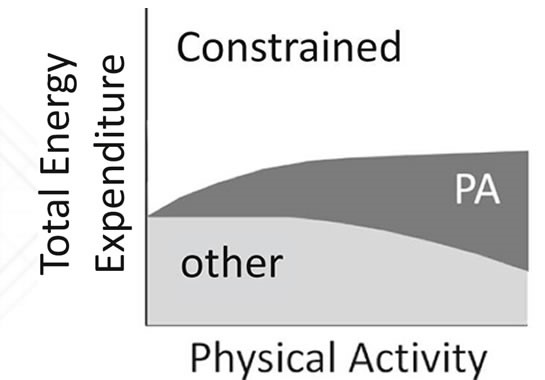
In short, what this model shows us is that our metabolism doesn’t work the way we’ve always thought that it did. It turns out that if we walk 20,000 steps in a day, we don’t actually burn any more total calories than if we walked 10,000 steps.
Instead, when we walk 20,000 steps, our body simply redirects energy from other biological functions to meet the demand – we’ll talk more about the specifics of that shortly.
Although it may seem crazy to suggest that people living in hunter-gatherer tribal societies don’t really burn more calories in a day than most Americans – when corrected for body mass – it’s what the research shows.
This new model of energy expenditure makes it clear that there’s an upper limit to how many calories we can burn in given a day. No matter how active we are, it turns out that our metabolism is ultimately limited in the amount of energy it can produce and thus the number of calories we end up burning.
A great view of how this all works can be seen from looking at a similar study, titled “Increases in Physical Activity Result in Diminishing Increments in Daily Energy Expenditure in Mice,” where researchers looked at different activity levels and energy expenditure in mice using the same doubly labeled water technique.
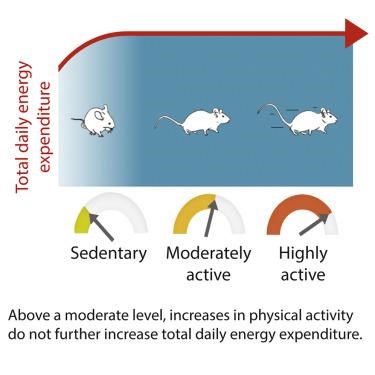
As you can see, the mice that were moderately active did, in fact, end up burning more calories than the mice that were couch potatoes. The highly active mice, on the other hand, essentially burned the same amount of total calories as the moderately active mice.
Again, this supports a model where our metabolism has its limits and the maximum amount of energy our metabolism can generate is much more fixed than we ever knew.
The importance of this new way of looking at energy and its relationship to activity cannot be overstated – it explains a lot.
The energy dilemma and why it’s so crucial to your fitness goals
Now that we know there’s only so much energy our body can generate in a day, let’s look at different processes in the body that are constantly demanding it. We can group these demands into three broad categories:
- vital biological functions
- physical activity and stress, and
- tissue repair and adaptation.
It’s important to consider that ultimately, it’s your brain and its complex computing power that decides where the energy you produce gets distributed.
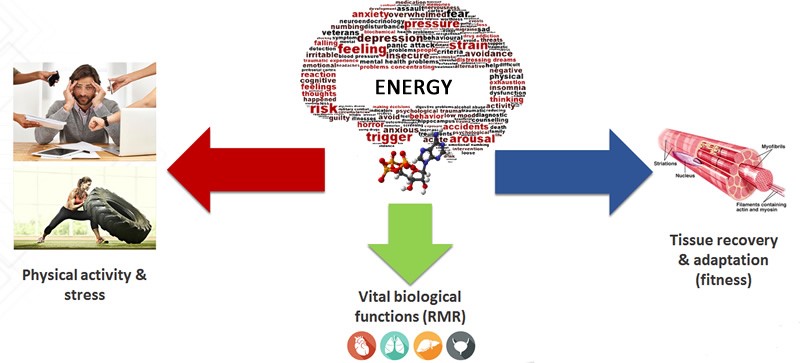
Your Brain’s First Priority: keeping you alive
Out of the three categories of energy demands, your vital biological functions (the energy that vital organs like your heart, lungs and brain require) are obviously the most crucial to survival.
When any of these tissues don’t get the energy they need, well, let’s just say it’s quickly game over.
Because of this, your brain’s first priority is always going to be directing energy to these areas, since there’s an absolute minimum amount that your body needs to stay alive in a day. This number is often referred to as your resting metabolic rate or RMR.
Your Brain’s Second Priority: powering your activity and dealing with life stress
The second category, physical activity, and stress are the most highly variable from day-to-day, and it’s also the one we have the most control over. We can choose whether to work out or sit on the couch. We can take the stairs or the elevator.
While it’s fairly obvious that the more physically active we are, the more energy our working muscles and supporting tissues will need, what most people don’t fully appreciate is just how much mental stress also affects our energy distribution.
The critical thing to know is that any time we’re mentally stressed, whether it’s because of an upcoming work deadline or test, financial worries, family issues, or because the driver in front of you is going slower than you’d like them to, our body’s stress response is activated.
When this happens, stress hormones are released into our bloodstream, our blood pressure increases and our brain works to mobilize our energy stores. While this is exactly what you need when dealing with a physically demanding stressor, like working out (or being chased by a bear), it’s not so great when the thing stressing you out is a slow driver.
This is because after the driver moves out of the way, or your exam is over, or the bills get paid, and you’re able to relax, then your body then has to put back all the energy it just mobilized but didn’t end up needing. Moving all this energy around, from storage to the bloodstream and back again, takes a good amount of energy in and of itself.
Another way to think of it: Imagine a warehouse where the workers are constantly having to get big, heavy boxes down off the upper shelves, only to put them back up there again minutes, or hours later. It’s not the most valuable way for them to spend their precious (limited) time.
In other words, there’s a real biological cost to mental stress and it’s paid in the form of energy. In my experience, the stress of life is a lot more expensive and plays a much bigger role in fitness, or lack thereof, than most people ever realize.
Your Brain’s Last Priority: improving your fitness (making you bigger, stronger, leaner, and meaner)
The third and final category of metabolic activity that demands energy is tissue repair and adaptation. When you’re training hard and trying to improve your fitness, it’s absolutely vital that enough energy gets distributed here. This is the energy that’s used to rebuild muscle tissue to make it bigger and stronger, to create new mitochondria that improve endurance and even to make changes in the brain that lead to enhanced coordination and skill.
If your goal is to get the most out of your training, the crucial thing to realize is that the brain is only going to devote energy to building bigger and stronger tissue when there is enough left over after your other basic metabolic needs and physical activity demands are met.
Your brain is definitely not going to sacrifice any of the energy it needs to keep you alive just so you can lift heavier weights, run faster, or look better in a bathing suit.
“Recovery Debt”: where fitness goes very wrong
When you consider the limited nature of our metabolism and all the energy demands within the body, it should be easy to see how so many training programs built around the intensity mindset end up going wrong.
Looking at the different stages of the training process in the diagram below, the biggest thing that stands out is that training, recovery, and the adaptations within the body that drive improvements in fitness all require a massive amount of energy.
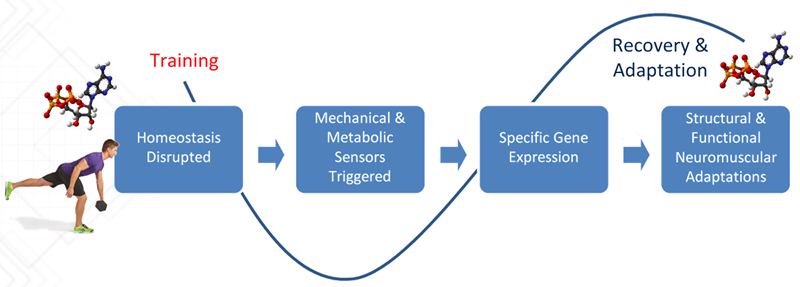
The harder you train, the longer you train for, the more energy your brain has to distribute to your working muscles and other tissues. At the same time, repairing all these cells and rebuilding muscle, mitochondria, tendons, and trillions of cells to make them bigger, stronger and capable of greater endurance also takes a massive amount of energy.
Given that our metabolism can only produce a finite amount of energy in a day, no matter how much food you eat or rest you get, what do you think happens when you pile on three, four, or even five high-intensity training sessions a week? What about when you couple all that training with the stress of daily life?
The answer is simple: you end up with what I call a recovery debt.
A recovery debt is what happens when you put a ton of stress on all the cells and tissues involved in training, without also giving them the energy they need for recovery and repair. You go in the gym, day in and day out, busting your ass and lifting weights, doing endless intervals, pushing yourself to the edge of fatigue and yet it never quite seems to pay off the way that it should, or the way that you thought it would.
What I’ve come to discover in the last few years is that the single biggest thing holding people back from reaching their fitness goals is exactly that: they are living in a constant state of recovery debt. I even have over 1.5 million heart variability data points from more than 15 thousand people that prove exactly this.
What the data shows is that most people are putting in the work but not getting the reward for one reason and one reason only: they are spending so much energy on training and dealing with the stress of daily life, that there’s just not enough left over to go towards recovery and rebuilding the body.
Remember, it’s the process of recovery and rebuilding that actually leads to improved fitness so when this doesn’t happen, the results just aren’t there, no matter how much effort may be.
https://www.8weeksout.com/2017/11/21/recovery-driven-fitness/
More about the Expert:
Joel Jamieson is widely considered one of the world’s foremost authorities on strength and conditioning for combat sports, having trained many of the sports best athletes since 2004. He is the author of the bestselling book “Ultimate MMA Conditioning” and is a contributing writer to several top magazines and a frequent guest speaker at conferences and seminars all over the world.
Joel has worked with and consulted extensively for teams and organizations ranging from Navy SEALS to Life Time Fitness and his BioForce HRV system is used by teams in the NFL, NBA, MLS, NCAA and more. He is best known for an individualized approach that is both based on solid science and yet practical to apply. Joel created 8WeeksOut in 2009 to help clear up the misinformation and confusion surrounding energy systems and since then, the site has become one of the authorities on strength, conditioning and performance.






